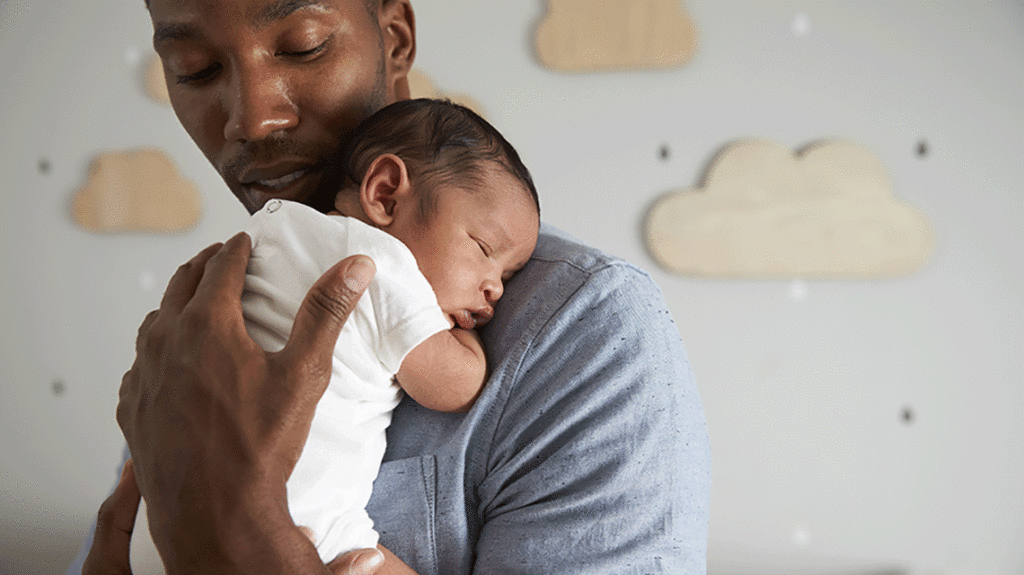Asymptomatic Infants With Congenital Cytomegalovirus May Still Have Detectable, Significant Abnormalities
Asymptomatic Infants With Congenital Cytomegalovirus May Still Have Detectable, Significant Abnormalities https://pediatricsnationwide.org/wp-content/uploads/2020/01/AdobeStock_144860523.gif-father-child-header-1024x575.gif 1024 575 Katie Brind'Amour, PhD, MS, CHES Katie Brind'Amour, PhD, MS, CHES https://pediatricsnationwide.org/wp-content/uploads/2021/03/Katie-B-portrait.gif- January 08, 2020
- Katie Brind'Amour, PhD, MS, CHES

More than half of high-risk CMV-positive newborns may have abnormalities not detected by a physical exam alone.
A study in 34 infants with a normal physical exam despite a positive diagnosis of congenital cytomegalovirus (CMV) — a viral infection that can lead to neurodevelopmental delays and permanent hearing loss — found that in more than half of these cases, infants had at least one abnormality upon further examination. Some of these children merited treatment with antiviral therapy, which under many management strategies would have been omitted due to the normal physical exam, leaving children at risk for future complications due to CMV.
“There is no consensus on what to do with babies who have a congenital CMV diagnosis. Only 10% have signs detectable on a physical exam,” says Pablo Sanchez, MD, principal investigator in the Center for Perinatal Research at the Abigail Wexner Research Institute, and a neonatologist and pediatric infectious disease specialist at Nationwide Children’s Hospital. He is senior author on the recent publication, which included research he helped conduct in his former role with the University of Texas Southwestern Medical Center. “Ninety percent appear normal, but these children may develop problems later. This paper showed that actually, many of those apparently healthy infants do have signs that suggest the virus is active and should be treated.”
The study, a multi-center retrospective review (1996-2017) of patient records for newborns at hospitals in Dallas, Texas and Buenos Aires, Argentina, reviewed the results of complete blood cell count and platelet tests, liver function tests, eye exams, head ultrasounds or other neuroimaging, and brainstem evoked responses for all children born with congenital CMV who had a normal physical exam. Fifty-six percent had at least one abnormality on these tests, including abnormal neuroimaging (45%), elevated serum alanine aminotransferase (ALT) concentration (39%), anemia (12%), low platelet count (thrombocytopenia) (16%) and/or inflamed retinas and choroids (chorioretinitis) (3%).
Of the infants identified in the retrospective review, 21% experienced sensorineural hearing loss and more than half (18 of the 34) ended up receiving antiviral treatment.
This potential risk to such apparently healthy children is a primary reason Dr. Sanchez supports more in-depth evaluation of any infants who test positive for congenital CMV. He also recommends 6 months of oral valganciclovir therapy for children with any abnormality detected on these more rigorous evaluations. Only babies with normal physical exams and normal subsequent testing do not routinely receive therapy in his practice.
“I’m of the opinion that if treatment can improve hearing outcomes in first 2 years of life, it is important to treat even without manifest signs of serious infection,” says Dr. Sanchez, who is also the director of Clinical and Translational Research in Neonatology at Nationwide Children’s and a professor of pediatrics at The Ohio State University College of Medicine. He also participates in a trial offering therapy to totally asymptomatic congenital CMV-positive infants to help determine if proactive therapy improves hearing outcomes through age 2.
Dr. Sanchez acknowledges the current study’s small sample size and the fact that the infants in the review were high-risk for other factors (such as maternal HIV infection). Even if the ultimate proportions of children with abnormalities detected on follow-up evaluation are lower, however, he endorses a proactive approach.
“Watchful waiting is potentially counterproductive, because therapy must be administered in the first three weeks of life to be effective at preventing hearing loss,” says Dr. Sanchez. Despite the chance of missing the treatment window, some guidelines suggest treatment only be administered if and when more dramatic signs of active infection occur. Instead, Dr. Sanchez currently advocates referring all children who fail their newborn hearing test for a CMV test, and he routinely offers the same range of bloodwork, eye exams and head ultrasounds described in the study to all congenital CMV patients.
To learn more about opportunities for late treatment, Dr. Sanchez and his team are involved in a multi-institutional trial to investigate whether antiviral administration to older infants may also prevent hearing loss through the age of 2. In addition, he has initiated a study to test all neonatal intensive care unit (NICU) infants at Nationwide Children’s for congenital CMV in the hopes of catching some of these infants before problems occur, since many of these babies are so little that hearing screening may be delayed until they are past the point of potential antiviral efficacy for preventing hearing loss.
“We’re taking a team approach to babies with congenital CMV,” says Dr. Sanchez, who works with social work, hearing, neurology, infectious disease, radiology and other teams to diagnose and manage CMV babies. “And our major goal is to identify hearing disorders and neurodevelopmental impairment early, to optimize their outcomes.”
Reference:
Ronchi A, Zeray F, Lee LE, Owen KE, Shoup AG, Garcia F, Vazquez LN, Cantey JB, Varghese S, Pugni L, Mosca F, Sanchez PJ. Evaluation of clinically asymptomatic high risk infants with congenital cytomegalovirus infection. Journal of Perinatology, 2020. 40;89-96.
Photo credit: Adobe Stock
About the author
Katherine (Katie) Brind’Amour is a freelance medical and health science writer based in Pennsylvania. She has written about nearly every therapeutic area for patients, doctors and the general public. Dr. Brind’Amour specializes in health literacy and patient education. She completed her BS and MS degrees in Biology at Arizona State University and her PhD in Health Services Management and Policy at The Ohio State University. She is a Certified Health Education Specialist and is interested in health promotion via health programs and the communication of medical information.
-
Katie Brind'Amour, PhD, MS, CHEShttps://pediatricsnationwide.org/author/katie-brindamour-phd-ms-ches/April 27, 2014
-
Katie Brind'Amour, PhD, MS, CHEShttps://pediatricsnationwide.org/author/katie-brindamour-phd-ms-ches/April 27, 2014
-
Katie Brind'Amour, PhD, MS, CHEShttps://pediatricsnationwide.org/author/katie-brindamour-phd-ms-ches/April 27, 2014
-
Katie Brind'Amour, PhD, MS, CHEShttps://pediatricsnationwide.org/author/katie-brindamour-phd-ms-ches/April 28, 2014







